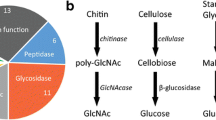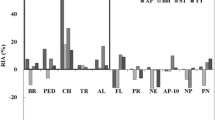Abstract
Three pepsinogen isolates (PG-I till III) from the stomach of rainbow trout (Oncorhynchus mykiss) were purified by using ammonium sulfate precipitation, ion exchange chromatography, and two subsequent gel filtrations containing seven pepsinogen isoforms. SDS-PAGE revealed that pepsinogen isolate I contained two isoforms with molecular masses of 45 kDa (PG-I a) and 44 kDa (PG-I b) and the molecular masses of the PG isolates PG-II and PG-III were 42 kDa, respectively. P-I till P-III converted into the corresponding pepsins (P) at pH 2.0 with molecular masses of 37 kDa (P-I a, b, P-III) and 35 kDa (P-II). The isoelectric points were 4.0 (PG-I a, b), 5.9 (PG-II), and pepsinogen isolate III exhibited four isoforms with isoelectric points of 3.73 (PG-III a), 3.78 (PG-III b), 4.0 (PG-III c) and 4.15 (PG-III d). After conversion from pepsinogen, trout pepsins exhibited optimal activity at pH 3.0 and 40 °C (P-I) and pH 2.5 and 30 °C (P-II, P-III). The N-terminal amino acid sequences of the three pepsin isolates (P-I till III) were determined up to 20 amino acids. P-II showed 100 % identity (ID) to pepsin A of Oncorhynchus keta, but P-I and P-III revealed high similarity to chitinases (85 % ID). Catalytic constants KM and kcat for proteolysis of acid-denatured hemoglobin were determined as 2.8 × 10−8 M (P-I), 1.3 × 10−8 M (P-II) and 7.9 × 10−9 M (P-III), and 5.43–19.1 S−1, respectively.







Similar content being viewed by others
References
Kageyama T (2002) Pepsinogens, progastricsins, and prochymosins: structure, function, evolution, and development. Cell Mol Life Sci 59(2):288–306
Bougatef A, Balti R, Zaied SB, Souissi N, Nasri M (2008) Pepsinogen and pepsin from the stomach of smooth hound (Mustelus mustelus): purification, characterization and amino acid terminal sequences. Food Chem 107(2):777–784
Stanley DW, Emmons DB (1977) Cheddar cheese made with bovine pepsin II. Texture—microstructure—composition relationships. Can Inst Food Sci Technol J 10(2):78–84
Tavares JF, Baptista JA, Marcone MF (1997) Milk-coagulating enzymes of tuna fish waste as a rennet substitute. Int J Food Sci Nutr 48(3):169–176
Vlahović B, Popović-Vranješ A, Mugoša I (2014) International cheese market–current state and perspective. Econ Insights Trends Chall 3:35–43
Llarena-Reino M, Pineiro C, Antonio J, Outerino L, Vello C, Gonzalez AF, Pascual S (2013) Optimization of the pepsin digestion method for anisakids inspection in the fishing industry. Vet Parasitol 191(3–4):276–283
Lassoued I, Jridi M, Nasri R, Dammak A, Hajji M, Nasri M, Barkia A (2014) Characteristics and functional properties of gelatin from thornback ray skin obtained by pepsin-aided process in comparison with commercial halal bovine gelatin. Food Hydrocoll 41:309–318
Zhao L, Budge SM, Ghaly AE, Brooks MS, Dave D (2011) Extraction, purification and characterization of fish pepsin: a critical review. J Food Process Technol 2(6):2–6
Klomklao Kishimura H, Yabe M, Benjakul S (2007) Purification and characterization of two pepsins from the stomach of pectoral rattail (Coryphaenoides pectoralis). Comp Biochem Physiol B Biochem Mol Biol 147(4):682–689
Gildberg A, Olsen RL, Bjarnason JB (1990) Catalytic properties and chemical composition of pepsins from Atlantic cod (Gadus morhua). Comp Biochem Physiol B Biochem Mol Biol 96(2):323–330
Brier S, Maria G, Carginale V, Capasso A, Wu Y, Taylor RM, Borotto NB, Capasso C, Engen JR (2007) Purification and characterization of pepsins A1 and A2 from the Antarctic rock cod Trematomus bernacchii. FEBS J 274(23):6152–6166
Nalinanon S, Benjakul S, Kishimura H (2010) Biochemical properties of pepsinogen and pepsin from the stomach of albacore tuna (Thunnus alalunga). Food Chem 121(1):49–55
Wu T, Sun L-C, Du C-H, Cai Q-F, Zhang Q-B, Su W-J, Cao M-J (2009) Identification of pepsinogens and pepsins from the stomach of European eel (Anguilla anguilla). Food Chem 115(1):137–142
Cao MJ, Chen WQ, Du CH, Yoshida A, Lan WG, Liu GM, Su WJ (2011) Pepsinogens and pepsins from Japanese seabass (Lateolabrax japonicus). Comp Biochem Physiol B 158(4):259–265
Vannabun A, Ketnawa S, Phongthai S, Benjakul S, Rawdkuen S (2014) Characterization of acid and alkaline proteases from viscera of farmed giant catfish. Food Biosci 6:9–16
Zhou Q, Liu GM, Huang YY, Weng L, Hara K, Su WJ, Cao MJ (2008) Pepsinogens and pepsins from mandarin fish (Siniperca chuatsi). J Agric Food Chem 56(13):5401–5406
Liaset B, Lied E, Espe M (2000) Enzymatic hydrolysis of by-products from the fish-filleting industry; chemical characterisation and nutritional evaluation. J Sci Food Agric 80(5):581–589
FEAP (2015) European aquaculture production report 2005–2014. Federation of European Aquaculture Producers. http://www.feap.info/Default.asp?SHORTCUT=582. Accessed 20 Aug 2015
Chen YC, Jaczynski J (2007) Protein recovery from rainbow trout (Oncorhynchus mykiss) processing byproducts via isoelectric solubilization/precipitation and its gelation properties as affected by functional additives. J Agric Food Chem 55(22):9079–9088
Twining SS, Alexander PA, Huibregtse K, Glick DM (1983) A pepsinogen from rainbow trout. Comp Biochem Physiol B 75(1):109–112
Tanji M, Yakabe E, Kageyama T, Yokobori S, Ichinose M, Miki K, Ito H, Takahashi K (2007) Purification and characterization of pepsinogens from the gastric mucosa of African coelacanth, Latimeria chalumnae, and properties of the major pepsins. Comp Biochem Physiol B Biochem Mol Biol 146(3):412–420
Zhou Q, Fu X-P, Zhang L-J, Su W-J, Cao M-J (2007) Purification and characterization of sea bream (Sparus latus houttuyn) pepsinogens and pepsins. Food Chem 103(3):795–801
Bradford MM (1976) A rapid and sensitive method for the quantitation of microgram quantities of protein utilizing the principle of protein-dye binding. Anal Biochem 72(1):248–254
Xu RA, Wong RJ, Rogers ML, Fletcher GC (1996) Purification and characterization of acidic proteases from the stomach of the deepwater finfish orange roughy (Hoplostethus atlanticus). J Food Biochem 20(6):31–48
Ryle AF (1984) Pepsins, gastricsins and their zymogens. In: Bergmeyer HU (ed) Methods of enzymatic analysis. Verlag Chemie, Weinheim, pp 223–238
Laemmli UK (1970) Cleavage of structural proteins during the assembly of the head of bacteriophage T4. Nature 227(5259):680–685
Altinelataman C, Kündiger R, Cakli S, Rehbein H (2009) Comparison of IEF patterns of sarcoplasmic proteins of fish from North Atlantic and Aegean Sea. Food Control 20(11):980–985
Heukeshoven J, Dernick R (1985) Simplified method for silver staining of proteins in polyacrylamide gels and the mechanism of silver staining. Electrophoresis 6(3):103–112
Lineweaver H, Burk D (1934) The determination of enzyme dissociation constants. J Am Chem Soc 56(3):658–666
Edman P (1949) A method for the determination of amino acid sequence in peptides. Arch Biochem Biophys 22(3):475
Gildberg A, Raa J (1983) Purification and characterization of pepsins from the arctic fish capelin (Mallotus villosus). Comp Biochem Physiol A Comp Physiol 75(3):337–342
Marciniszyn J Jr, Huang JS, Hartsuck JA, Tang J (1976) Mechanism of intramolecular activation of pepsinogen. Evidence for an intermediate delta and the involvement of the active site of pepsin in the intramolecular activation of pepsinogen. J Biol Chem 251(22):7095–7102
Sanchez-Chiang L, Cisternas E, Ponce O (1987) Partial purification of pepsins from adult and juvenile salmon fish Oncorhynchus keta. Effect of NaCl on proteolytic activities. Comp Biochem Physiol B Biochem Mol Biol 87(4):793–797
Arunchalam K, Haard NF (1985) Isolation and characterization of pepsin from polar cod (Boreogadus saida). Comp Biochem Physiol B Biochem Mol Biol 80(3):467–473
Tanji M, Yakabe E, Kubota K, Kageyama T, Ichinose M, Miki K, Ito H, Takahashi K (2009) Structural and phylogenetic comparison of three pepsinogens from Pacific bluefin tuna: molecular evolution of fish pepsinogens. Comp Biochem Physiol B Biochem Mol Biol 152(1):9–19
Tanji M, Kageyama T, Takahashi K (1988) Tuna pepsinogens and pepsins. Purification, characterization and amino-terminal sequences. Eur J Biochem 177(2):251–259
Sugiura SH, Roy PK, Ferraris RP (2006) Dietary acidification enhances phosphorus digestibility but decreases H+/K+−ATPase expression in rainbow trout. J Exp Biol 209(19):3719–3728. doi:10.1242/jeb.02436
Gildberg A (1988) Aspartic proteinases in fishes and aquatic invertebrates. Comp Biochem Physiol B Comp Biochem 91(3):425–435
Bucking C, Wood CM (2006) Gastrointestinal processing of Na+, Cl−, and K+ during digestion: implications for homeostatic balance in freshwater rainbow trout. Am J Physiol Regul Integr Comp Physiol 291(6):R1764–R1772. doi:10.1152/ajpregu.00224.2006
Brier S, Maria G, Carginale V, Capasso A, Wu Y, Taylor RM, Borotto NB, Capasso C, Engen JR (2007) Purification and characterization of pepsins A1 and A2 from the Antarctic rock cod Trematomus bernacchii. FEBS J 274(23):6152–6166
Benhabiles MS, Abdi N, Drouiche N, Lounici H, Pauss A, Goosen MFA, Mameri N (2012) Fish protein hydrolysate production from sardine solid waste by crude pepsin enzymatic hydrolysis in a bioreactor coupled to an ultrafiltration unit. Mater Sci Eng C 32(4):922–928
Hartsuck JA, Koelsch G, Remington SJ (1992) The high-resolution crystal structure of porcine pepsinogen. Proteins 13(1):1–25
Acknowledgments
This work was supported by the Hessen’s state government under the program “research for practice”.
Author information
Authors and Affiliations
Corresponding author
Ethics declarations
Conflict of interest
The authors declare that they have no conflict of interest.
Electronic supplementary material
Below is the link to the electronic supplementary material.
Rights and permissions
About this article
Cite this article
Wald, M., Rehbein, H., Beermann, C. et al. Purification and characterization of pepsinogen and pepsin from the stomach of rainbow trout (Oncorhynchus mykiss). Eur Food Res Technol 242, 1925–1935 (2016). https://doi.org/10.1007/s00217-016-2692-2
Received:
Revised:
Accepted:
Published:
Issue Date:
DOI: https://doi.org/10.1007/s00217-016-2692-2




